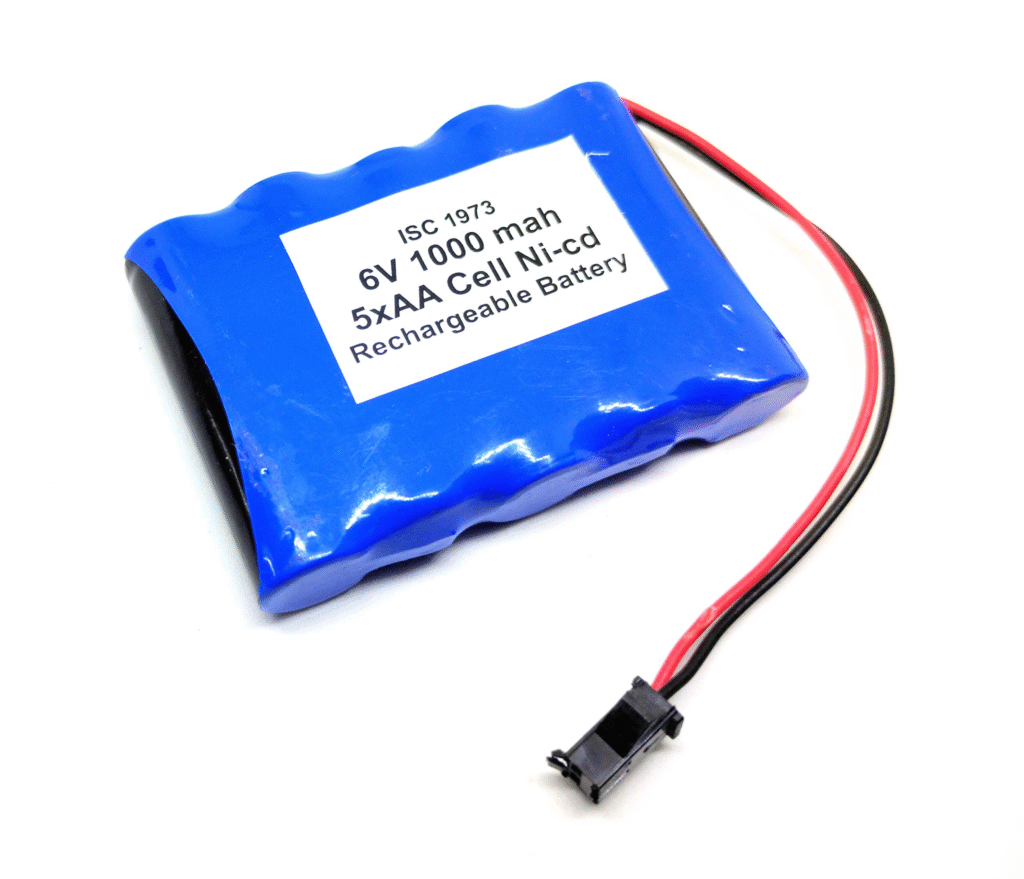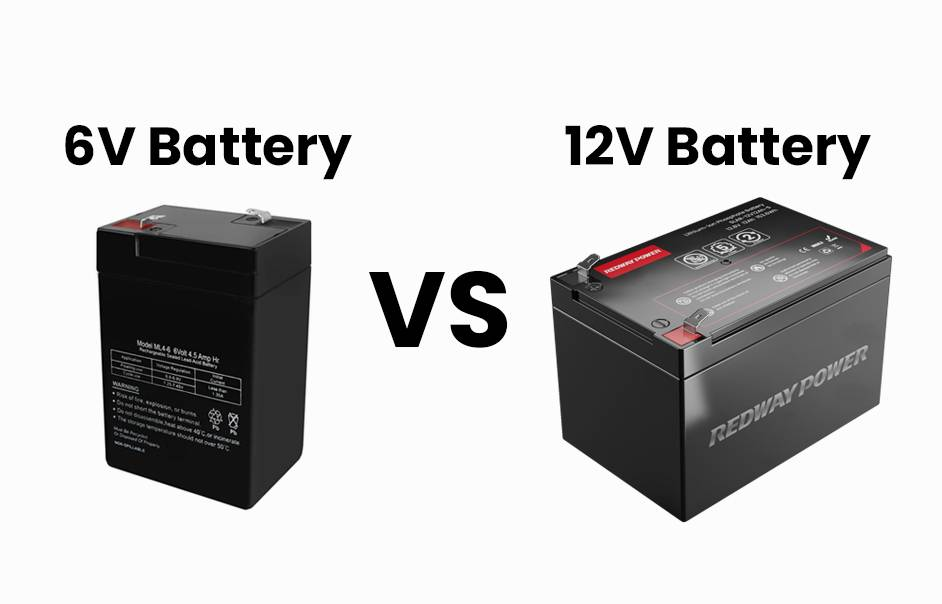6-volt batteries are still common today. You will find them in RVs, golf carts, solar systems, and even vintage cars. They are popular because they are durable and can handle deep discharges.
This guide explains what a 6-volt battery is, how it works, its main types, key specs, how to charge it, and how to make it last longer.
What Is a 6-Volt Battery?
A “6-volt battery” simply means a battery with a nominal voltage of about 6 V.
Construction: A lead-acid 6 V battery is made of three individual 2 V cells connected in series inside one case.
Chemistries: They can be Flooded Lead-Acid, AGM (Absorbent Glass Mat), Gel, or even lithium iron phosphate (LiFePO₄) packs that are marketed as “6 V” but have a nominal voltage around 6.4 V.
Applications: Common in golf carts, RVs (wired in series for 12 V house banks), small solar storage systems, floor scrubbers, and backup power systems.

How a 6-Volt Battery Works
A lead-acid 6 V battery works through electrochemical reactions:
Discharge: Lead dioxide (positive plate) and sponge lead (negative plate) react with sulfuric acid to form lead sulfate and release electrons, producing electrical energy.
Charge: When connected to a charger, the reaction is reversed — lead sulfate converts back into lead dioxide and sponge lead, restoring the battery’s capacity.
The process is temperature-dependent and affected by depth of discharge (DoD). Proper charging and maintenance are critical to maximize life.
Types of 6-Volt Batteries (Pros & Cons)
| Type | Key Benefits | Limitations | Typical Uses |
|---|---|---|---|
| Flooded Lead-Acid (FLA) | Low cost, serviceable (water can be added), robust for deep cycles | Requires maintenance, prone to spills, needs ventilation | Golf carts, solar storage, floor scrubbers |
| AGM (Sealed Lead-Acid) | Maintenance-free, vibration-resistant, spill-proof, faster charge acceptance | Higher cost, can be damaged by over-voltage | RVs, marine, backup power |
| Gel | Excellent deep-cycle ability, completely sealed, low self-discharge | Sensitive to over-charging, lower peak current | Medical devices, mobility scooters, UPS |
| LiFePO₄ (6.4 V nominal) | Very light, 3000+ cycles, 80–100% usable capacity, no maintenance | High upfront cost, requires BMS/compatible charger | Premium RV & solar systems, off-grid power |
6 V vs 12 V Batteries — Which Should You Choose?
Two 6 V batteries wired in series give you a 12 V system with the same amp-hour capacity. Many RVers prefer this setup because:
Deep-cycle 6 V batteries use thicker plates, which makes them more durable under repeated cycling.
They often last longer (more cycles) than standard 12 V deep-cycle batteries of similar cost.
On the other hand, a single 12 V battery is simpler to install and usually takes up less space. Your choice depends on available space, budget, and performance needs.

Key Specifications to Look For
Voltage: Nominal 6 V (or 6.4 V for LiFePO₄).
Capacity (Ah): Deep-cycle 6 V golf-cart batteries typically range from 200 – 235 Ah (20-hour rate).
Dimensions: Most 6 V FLA batteries use the BCI GC2 group size (≈10.38″ L × 7.13″ W × 10.88″ H).
Weight: A typical flooded GC2 battery weighs around 62 lb (28 kg).
Reserve Minutes: For example, a Trojan T-105 provides ~447 minutes at 25 A draw.
Cycle Life: FLA 500–700 cycles @ 50% DoD, AGM 700–1000 cycles, LiFePO₄ 3000+ cycles.
Charging Best Practices
Lead-Acid (Flooded / AGM / Gel)
Bulk / Absorption: ~7.35 – 7.50 V (25 °C)
Float: ~6.75 V
Equalize: ~7.8 – 7.95 V (only for flooded batteries)
Use a three-stage smart charger and temperature compensation when possible. Never use a 12 V-only charger on a single 6 V battery — either use a dedicated 6 V charger or charge two in series with a 12 V charger.
LiFePO₄ (6.4 V nominal)
Charge to about 7.2 – 7.3 V, using a charger with a LiFePO₄ profile and built-in protections (BMS compatibility).
Factors That Affect Battery Life
Depth of Discharge: Shallower cycles dramatically extend life. Keeping DoD around 50% is ideal for lead-acid.
Temperature: Extreme heat accelerates plate corrosion; cold slows charging efficiency.
Maintenance: Keep flooded cells topped up with distilled water, terminals clean, and batteries fully charged during storage.
Charge Accuracy: Over- or under-charging shortens life — follow manufacturer’s voltage specs.
Typical Applications
Golf carts and utility carts (classic GC2 size)
RVs and campers (two in series for 12 V house banks)
Small off-grid solar systems
Backup power for homes or businesses
Vintage vehicles and tractors still using 6 V systems
Frequently Asked Questions (FAQ)
Can I replace a 12 V battery with two 6 V batteries?
Yes — connect two 6 V in series (negative of the first to positive of the second) to get 12 V output.
How long does a 6 V battery last?
Typically 4–8 years for quality deep-cycle FLA batteries if properly maintained; LiFePO₄ versions can last 10+ years.
How do I know if my 6 V battery is bad?
After a full charge and rest, measure open-circuit voltage. Anything below ~6.1 V for a flooded battery may indicate it’s failing.
Do I need to water a 6 V battery?
Only flooded lead-acid batteries require watering — AGM, Gel, and LiFePO₄ are sealed and maintenance-free.
Can I store my 6 V battery for winter?
Yes, but store fully charged in a cool, dry place and top off charge every 1–3 months to avoid sulfation.
Conclusion
6-volt batteries remain one of the most reliable, cost-effective deep-cycle solutions available. Whether you’re building a solar battery bank, upgrading an RV, or maintaining a golf cart fleet, choosing the right chemistry, charging it correctly, and following good maintenance practices will ensure maximum performance and longevity.




